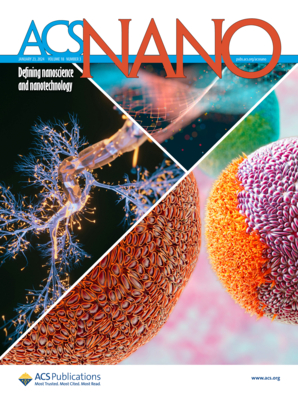Electron Microscopy for Nanophononics: A Review.
IF 16
1区 材料科学
Q1 CHEMISTRY, MULTIDISCIPLINARY
引用次数: 0
Abstract
Phonons, the quantized vibrations of crystal lattices, are essential to determining the material properties. At (sub)nanoscale, surfaces, heterointerfaces, crystal defects, and other imperfections generate localized phonon modes that can significantly alter materials' thermal, electrical, optical, and mechanical properties. However, conventional techniques often struggle to probe these localized phonon modes due to limitations in spatial resolution, momentum transfer, and penetration depth. Recent advancements in electron energy loss spectroscopy in scanning transmission electron microscopy (STEM-EELS) have overcome these challenges, achieving (sub)nanometer spatial resolution, several Brillouin Zones of momentum transfer, and millielectronvolt energy resolution, providing opportunities to probe the local phonons and their properties. This Review examines the theoretical framework of resolution control and local phonon detection in STEM-EELS, while comprehensively discussing experimental advancements and their applications in various materials systems. Given its flexibility to finely tune both spatial and momentum resolutions, this approach enables precise detection of local phonon density of states in defect structures, heterointerfaces, and nanoscale systems, as well as achieving nanometer-scale spatial resolution for phonon dispersion measurements. Additionally, the application and potential of such a method for studying thermal, electrical, and optical properties as well as detecting vibrations in molecules are also discussed. With rapid development, vibrational STEM-EELS is expected to play an increasingly important role in materials science, condensed matter physics, and chemistry in the future.纳米声子的电子显微镜:综述。
声子是晶体晶格的量子化振动,是决定材料性质的关键。在(亚)纳米尺度下,表面、异质界面、晶体缺陷和其他缺陷会产生局部声子模式,从而显著改变材料的热、电、光学和机械性能。然而,由于空间分辨率、动量传递和穿透深度的限制,传统技术往往难以探测这些局域声子模式。扫描透射电子显微镜(STEM-EELS)中电子能量损失谱的最新进展克服了这些挑战,实现了(亚)纳米空间分辨率、动量传递的几个布里渊区和毫电子伏能量分辨率,为探测局部声子及其性质提供了机会。本文综述了STEM-EELS中分辨率控制和局部声子检测的理论框架,同时全面讨论了实验进展及其在各种材料系统中的应用。由于该方法可以灵活地微调空间和动量分辨率,因此可以精确检测缺陷结构、异质界面和纳米级系统中状态的局部声子密度,并实现声子色散测量的纳米级空间分辨率。此外,还讨论了这种方法在研究热、电、光学性质以及检测分子振动方面的应用和潜力。随着振动STEM-EELS的快速发展,未来它将在材料科学、凝聚态物理和化学等领域发挥越来越重要的作用。
本文章由计算机程序翻译,如有差异,请以英文原文为准。
求助全文
约1分钟内获得全文
求助全文
来源期刊

ACS Nano
工程技术-材料科学:综合
CiteScore
26.00
自引率
4.10%
发文量
1627
审稿时长
1.7 months
期刊介绍:
ACS Nano, published monthly, serves as an international forum for comprehensive articles on nanoscience and nanotechnology research at the intersections of chemistry, biology, materials science, physics, and engineering. The journal fosters communication among scientists in these communities, facilitating collaboration, new research opportunities, and advancements through discoveries. ACS Nano covers synthesis, assembly, characterization, theory, and simulation of nanostructures, nanobiotechnology, nanofabrication, methods and tools for nanoscience and nanotechnology, and self- and directed-assembly. Alongside original research articles, it offers thorough reviews, perspectives on cutting-edge research, and discussions envisioning the future of nanoscience and nanotechnology.
 求助内容:
求助内容: 应助结果提醒方式:
应助结果提醒方式:


